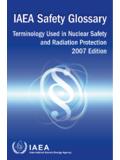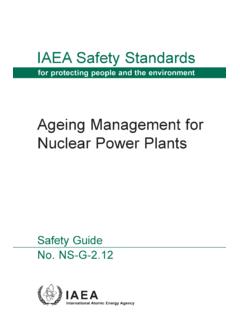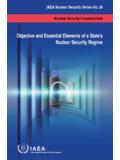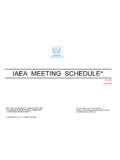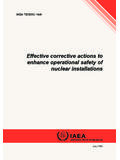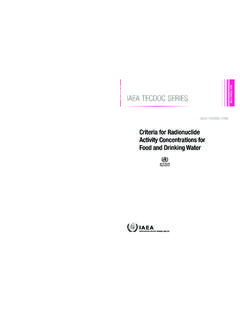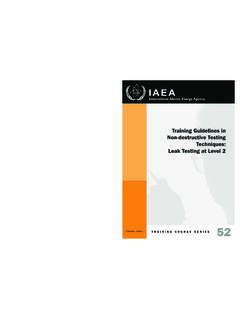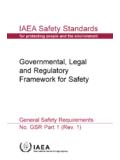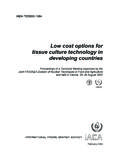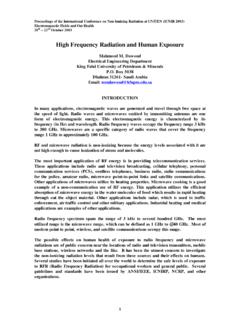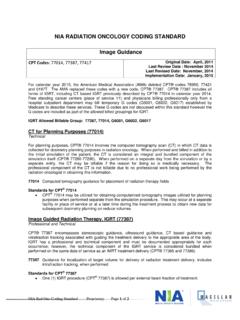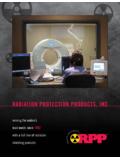Transcription of Radioactive Material Transport of Radiation …
1 IAEA Safety Standards for protecting people and the environment Radiation protection Programmes for the Transport of Radioactive Material Safety Guide No. Radiation protection . PROGRAMMES FOR THE. Transport OF. Radioactive Material . Safety standards survey The IAEA welcomes your response. Please see: The following States are Members of the International Atomic Energy Agency: AFGHANISTAN GREECE NORWAY. ALBANIA GUATEMALA PAKISTAN. ALGERIA HAITI PALAU. ANGOLA HOLY SEE PANAMA. ARGENTINA HONDURAS PARAGUAY. ARMENIA HUNGARY PERU. AUSTRALIA ICELAND PHILIPPINES. AUSTRIA INDIA POLAND. AZERBAIJAN INDONESIA PORTUGAL. BANGLADESH IRAN, ISLAMIC REPUBLIC OF QATAR. BELARUS IRAQ REPUBLIC OF MOLDOVA. BELGIUM IRELAND ROMANIA. BELIZE ISRAEL RUSSIAN FEDERATION. BENIN ITALY SAUDI ARABIA. BOLIVIA JAMAICA SENEGAL.
2 BOSNIA AND HERZEGOVINA JAPAN SERBIA. BOTSWANA JORDAN SEYCHELLES. BRAZIL KAZAKHSTAN SIERRA LEONE. BULGARIA KENYA SINGAPORE. BURKINA FASO KOREA, REPUBLIC OF SLOVAKIA. CAMEROON KUWAIT SLOVENIA. CANADA KYRGYZSTAN SOUTH AFRICA. CENTRAL AFRICAN LATVIA SPAIN. REPUBLIC LEBANON SRI LANKA. CHAD LIBERIA SUDAN. CHILE LIBYAN ARAB JAMAHIRIYA SWEDEN. CHINA LIECHTENSTEIN SWITZERLAND. COLOMBIA LITHUANIA SYRIAN ARAB REPUBLIC. COSTA RICA LUXEMBOURG TAJIKISTAN. C TE D'IVOIRE MADAGASCAR THAILAND. CROATIA MALAWI THE FORMER YUGOSLAV. CUBA MALAYSIA REPUBLIC OF MACEDONIA. CYPRUS MALI TUNISIA. CZECH REPUBLIC MALTA TURKEY. DEMOCRATIC REPUBLIC MARSHALL ISLANDS UGANDA. OF THE CONGO MAURITANIA UKRAINE. DENMARK MAURITIUS UNITED ARAB EMIRATES. DOMINICAN REPUBLIC MEXICO UNITED KINGDOM OF. ECUADOR MONACO GREAT BRITAIN AND.
3 EGYPT MONGOLIA NORTHERN IRELAND. EL SALVADOR MONTENEGRO UNITED REPUBLIC. ERITREA MOROCCO OF TANZANIA. ESTONIA MOZAMBIQUE UNITED STATES OF AMERICA. ETHIOPIA MYANMAR URUGUAY. FINLAND NAMIBIA UZBEKISTAN. FRANCE NETHERLANDS VENEZUELA. GABON NEW ZEALAND VIETNAM. GEORGIA NICARAGUA YEMEN. GERMANY NIGER ZAMBIA. GHANA NIGERIA ZIMBABWE. The Agency's Statute was approved on 23 October 1956 by the Conference on the Statute of the IAEA held at United Nations Headquarters, New York; it entered into force on 29 July 1957. The Headquarters of the Agency are situated in Vienna. Its principal objective is to accelerate and enlarge the contribution of atomic energy to peace, health and prosperity throughout the world''. IAEA SAFETY STANDARDS SERIES No. Radiation protection . PROGRAMMES FOR THE. Transport OF.
4 Radioactive Material . SAFETY GUIDE. INTERNATIONAL ATOMIC ENERGY AGENCY. VIENNA, 2007. COPYRIGHT NOTICE. All IAEA scientific and technical publications are protected by the terms of the Universal Copyright Convention as adopted in 1952 (Berne) and as revised in 1972 (Paris). The copyright has since been extended by the World Intellectual Property Organization (Geneva) to include electronic and virtual intellectual property. Permission to use whole or parts of texts contained in IAEA publications in printed or electronic form must be obtained and is usually subject to royalty agreements. Proposals for non-commercial reproductions and translations are welcomed and considered on a case-by-case basis. Enquiries should be addressed to the IAEA Publishing Section at: Sales and Promotion, Publishing Section International Atomic Energy Agency Wagramer Strasse 5.
5 Box 100. 1400 Vienna, Austria fax: +43 1 2600 29302. tel.: +43 1 2600 22417. email: IAEA, 2007. Printed by the IAEA in Austria October 2007. STI/PUB/1269. IAEA Library Cataloguing in Publication Data Radiation protection programmes for the Transport of Radioactive Material . Vienna : International Atomic Energy Agency, 2007. p. ; 24 cm. (Safety series, ISSN 1020 525X ; No. ). STI/DOC/1269. ISBN 92 0 109706 9. Includes bibliographical references. 1. Radioactive substances Transportation. 2. Radiation Safety measures. 3. Radioactivity Safety measures. I. International Atomic Energy Agency. II. Series. IAEAL 07 00492. FOREWORD. by Mohamed ElBaradei Director General The IAEA's Statute authorizes the Agency to establish safety standards to protect health and minimize danger to life and property standards which the IAEA must use in its own operations, and which a State can apply by means of its regulatory provisions for nuclear and Radiation safety.
6 A comprehensive body of safety standards under regular review, together with the IAEA's assistance in their application, has become a key element in a global safety regime. In the mid-1990s, a major overhaul of the IAEA's safety standards programme was initiated, with a revised oversight committee structure and a systematic approach to updating the entire corpus of standards. The new standards that have resulted are of a high calibre and reflect best practices in Member States. With the assistance of the Commission on Safety Standards, the IAEA is working to promote the global acceptance and use of its safety standards. Safety standards are only effective, however, if they are properly applied in practice. The IAEA's safety services which range in scope from engineering safety, operational safety, and Radiation , Transport and waste safety to regulatory matters and safety culture in organizations assist Member States in applying the standards and appraise their effectiveness.
7 These safety services enable valuable insights to be shared and I continue to urge all Member States to make use of them. Regulating nuclear and Radiation safety is a national responsibility, and many Member States have decided to adopt the IAEA's safety standards for use in their national regulations. For the Contracting Parties to the various international safety conventions, IAEA standards provide a consistent, reliable means of ensuring the effective fulfilment of obligations under the conventions. The standards are also applied by designers, manufacturers and operators around the world to enhance nuclear and Radiation safety in power generation, medicine, industry, agriculture, research and education. The IAEA takes seriously the enduring challenge for users and regulators everywhere: that of ensuring a high level of safety in the use of nuclear materials and Radiation sources around the world.
8 Their continuing utilization for the benefit of humankind must be managed in a safe manner, and the IAEA safety standards are designed to facilitate the achievement of that goal. CONTENTS. 1. INTRODUCTION .. 1. Background ( ).. 1. Objective ( ) .. 3. Scope ( ).. 4. Structure ( ) .. 4. 2. Radiation protection PROGRAMMES .. 4. Objectives of Radiation protection programmes ( ) .. 4. Operational Radiation protection ( ) .. 5. 3. REQUIREMENT FOR AND SCOPE OF A Radiation . protection PROGRAMME IN Transport .. 6. General ( ) .. 6. Meeting safety requirements ( ) .. 7. Elements of a Radiation protection programme ( ) .. 9. 4. BASIC ELEMENTS OF A Radiation protection . PROGRAMME AS A FUNCTION OF ASSESSED. OCCUPATIONAL DOSES .. 9. Occupational doses ( ) .. 9. Graded approach ( ) .. 10. 5. ASSIGNMENT OF ROLES AND RESPONSIBILITIES.
9 FOR THE ESTABLISHMENT OF A Radiation . protection PROGRAMME .. 11. Responsibility for establishing a Radiation protection programme ( ).. 11. Operator's responsibilities ( ) .. 11. Responsibilities of the competent authority ( ) .. 13. 6. DOSE ASSESSMENT AND OPTIMIZATION .. 14. Dose assessment principles ( ) .. 14. Monitoring ( ) .. 15. Methods of external dose assessment ( ) .. 17. Internal dose assessment methods ( ) .. 20. Dose limits, dose constraints and optimization ( ) .. 20. 7. SURFACE CONTAMINATION .. 22. Meeting requirements in respect of contamination ( ) .. 22. Control of contamination ( ) .. 23. 8. SEGREGATION AND OTHER PROTECTIVE MEASURES .. 24. Segregation ( ) .. 24. Limitation of exposure times ( ) .. 25. Use of shielding and shielding techniques ( ) .. 25. Controlled and supervised areas ( ).
10 26. 9. EMERGENCY RESPONSE .. 27. General ( ) .. 27. Emergency plan ( ).. 27. Emergency preparedness ( ) .. 28. 10. TRAINING .. 29. Need for training ( ) .. 29. Specific training and graded approach ( ) .. 30. 11. MANAGEMENT SYSTEMS FOR THE SAFE Transport . OF Radioactive Material .. 30. General ( ).. 30. Management systems ( ).. 30. REFERENCES .. 31. ANNEX I: GENERIC EXAMPLE OF A Radiation . protection PROGRAMME.. 35. ANNEX II: SPECIFIC EXAMPLE OF A Radiation . protection PROGRAMME FOR THE. Transport OF RADIOPHARMACEUTICALS .. 44. ANNEX III: SPECIFIC EXAMPLE OF A Radiation . protection protection PROGRAMME. FOR AN AIR CARGO CARRIER .. 49. ANNEX IV: SPECIFIC EXAMPLE OF A Radiation . protection PROGRAMME FOR AN. INDUSTRIAL RADIOGRAPHY INSTITUTION .. 54. ANNEX V: SPECIFIC EXAMPLE OF A Radiation .
